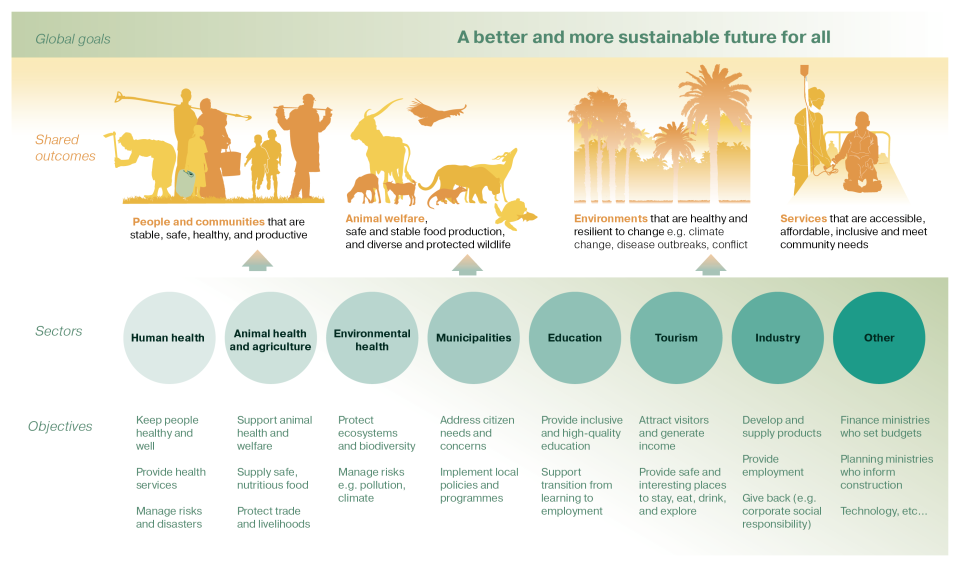Unlocking opportunities for One Health in Neglected Tropical Diseases

A new report out from WHO’s Neglected Tropical Diseases team tries to help those across human, animal and environment health work together to unlock new avenues for health. Dr Gabrielle Laing BVSc PhD MRCVS, Policy Advisor for One Health at the SCI Foundation, takes a look.
Interest in One Health has peaked over the last few years in light of the likely zoonotic origin of the COVID-19 pandemic. Zoonoses have long been an area for cross-sectoral collaboration, alongside foodborne infections, antimicrobial resistance or vector-borne disease. An updated definition of One Health from the newly established One Health High-Level Expert Council (OHHLEP) speaks to a broader movement in health however, one that goes beyond just avoidance of disease to, a system striving to balance the health and wellbeing of humans, animals and ecosystems (Tripartite and UNEP support OHHLEP’s definition of “One Health.” 2021) .
In 2021, the WHO released an updated road map for NTD control based on 3 pillars: accelerating programmatic action, intensifying cross-cutting approaches, and changing operating models and culture to facilitate country ownership. A companion document to this roadmap applies One Health to these pillars recommending integration of One Health into NTD programme design and delivery, coordination of action on NTDs across key sectors (beyond human health) and fostering a culture to sustain country-led One Health action.
Neglected Tropical Diseases are just that – neglected! And they are known to impact the most vulnerable communities, burdening those already disadvantaged. Some may be cautious therefore, that bringing together public health priorities with those from veterinary or environmental health may dilute priorities for human health. This is especially understandable for the already under resourced NTDs.
But the One Health companion document aims to allay those fears! The report was co-authored by the NNN (NTD NGO Network) One Health working group, and it aims to support countries, international organizations, and partners to work together to identify common ground across the sectors to maximize their efforts in progressing health for all.
But of course, there are already examples of cross-sector collaboration in NTDs. At the RSTMH Research in Progress meeting last year, I met Zikmund Bartonicek, a PhD candidate at the Natural History Museum and UCL. He explained his novel approach to surveillance for schistosomiasis via detecting the DNA of the parasite and its host snail that might be found in the faeces of fish that feed on them. This new approach could offer a more specific and less labour-intensive monitoring tool than current methods, helping to better understand the whole ecosystem surrounding an NTD and better inform decision-making for control. After obtaining promising results in the laboratory, Zikmund is now working on validating the method in the field.
The Companion Document
In the companion document, we draw on examples from around the world – Bhutan’s National One Health strategy, Brazil’s multidisciplinary health teams and Chad’s joint human and livestock vaccine campaigns. Successful cross-sectoral working has the potential for cost savings, logistical efficiencies, or improved data collection but, knowing where to start can be daunting. Additionally, the initial investment of time or resources to establish collaborations may seem beyond the reach for already stretched public health services.
However, as Yvonne Aki-Sawyerr OBE, Mayor of Freetown writes in the foreword ‘The first step is simple: explore where a One Health approach would be appropriate and beneficial to your context. Start now, start anywhere, with the context and resources available – and expand your approach as you build capability, connections, and momentum.’
A good place to start can be identifying ‘common ground’ between stakeholders, engaging others with an appreciation of their objectives and working together to find areas of synergy – see figure below.
Establishing co-design practices with communities, regular consultation with agriculture or forestry departments or capitalising on existing laboratory infrastructure from other sectors can be hugely rewarding and can help identify new avenues for reaching the NTD targets set out in the road map. Narrow approaches to NTDs may not only miss opportunities for global and local health systems but, any initiatives and actions inconsiderate of other disciplines, or the social, economic and cultural contexts, may result in unforeseen and detrimental consequences.
The OHHLEP also directly acknowledged this current lack of social and behavioural science expertise required for successful One Health. Similarly, we need suitable evaluation methods to demonstrate the value One Health can deliver, for example economic evaluations that place a higher value on prevention over cure and can measure costs and benefits across multiple sectors. The companion document has examples of common One Health challenges and how they can be overcome as well as illustrative cases studies throughout.
In order to deliver the benefits One Health can offer, there are certain competences that the workforce must hold. As a member of the Network for Ecohealth and One Health (NEOH), I have also been developing a set of core competences for those practicing One Health. These align with the broader OHHLEP definition of One Health and when combined with subject-specific expertise can deliver the paradigm shift needed to tackle the complexity of NTD prevention and control. (Watch this space for more on the competences.)
To end on a quote from the Director-General of the FAO, Dr. QU Dongyu, who closed his speech at the 2020 Paris Peace Forum with the wish that all join him in proclaiming “All for One health, and One Health for All; since United we stand, but divided we fall”.
Register here to attend WHO webinar to launch the One Health companion document to the NTD road map, 16th March 2022.

